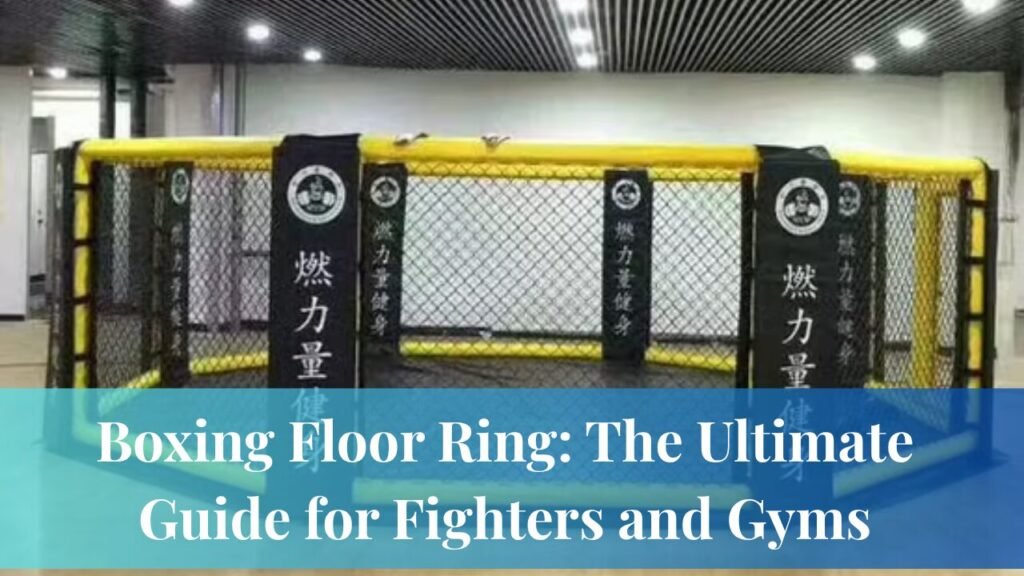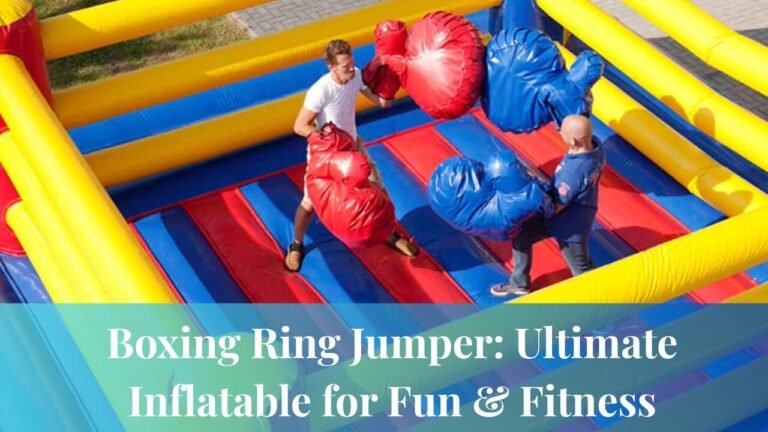A boxing floor ring is a ground-level, non-elevated boxing ring that provides the same functionality as a standard ring without the platform. It sits directly on the floor, making it easier to install and more versatile in compact training spaces. These rings are especially popular among home gym owners, personal trainers, youth sports clubs, pop-up boxing event organizers, and fitness centers expanding into combat sports.
Because they don’t require stairs, platforms, or anchoring into the floor, boxing floor rings offer accessibility and flexibility that elevated rings cannot. They provide an ideal setup for varied training environments where permanent installations are not feasible or where mobility and ease of access are essential.
Advantages of Boxing Floor Rings
One of the biggest selling points of a boxing floor ring is its affordability. Without the added cost of constructing a platform or elevated base, gyms and individuals can save significantly. Most floor rings cost between £800 and £5,000 depending on the materials, size, and features, whereas elevated rings can exceed that range due to the added construction.
Floor rings are also an excellent solution for tight training spaces. Since they do not require vertical clearance or structural support underneath, they fit easily into garages, basements, and small fitness studios. Their modular design also makes them suitable for shared spaces or multi-use gym floors. They are easy to assemble, often within just a few hours by two to three people, and many commercial models feature pre-drilled holes, color-coded components, and simple tools for assembly.
Several models on the market are designed to be disassembled and reassembled with ease, making them perfect for boxing event organizers or trainers who run classes in different locations. Floor rings make it easier for younger athletes, older adults, or those with limited mobility to participate in boxing. With no stairs to climb, they ensure safety and inclusivity, which can be a major advantage for community programs or therapy-based fitness sessions.
Components of a High-Quality Boxing Floor Ring
The frame should be constructed from industrial-grade steel or reinforced aluminum to handle consistent impact. Welded or bolted frames are common, with most featuring rust-resistant coatings for longevity. Professional boxing floor rings come with three or four ropes secured through corner and rope posts. Turnbuckles are used to keep the ropes taut and provide the required rebound. Look for models with adjustable tension and covered turnbuckles for safety.
Each corner typically includes thick foam padding wrapped in vinyl. Corner pads must include standard color schemes red, blue, and two neutral white corners to adhere to training and competition standards. The canvas surface must be durable, tear-resistant, and provide a non-slip experience for fighters. Underneath the canvas, foam padding or EVA mats should be installed for shock absorption. Most boxing floor rings are available in sizes ranging from 12ft to 24ft. A 16ft ring is ideal for amateur training, while professionals often use 20ft or larger rings. Although the ring sits on the floor, the rope height should match that of elevated rings to simulate a real fight environment.
Leading Brands and Retailers
Boxing Essential is a top supplier of professional-grade boxing equipment. Their floor rings are made from heavy-duty steel and are available in various sizes. Their floor rings are ideal for boxing clubs and offer excellent value. Boxfit UK offers several floor boxing ring options suitable for both amateur and professional use. They are especially known for their customizable rings and fast shipping.
Pro Fight Shop sells a range of boxing rings, including floor rings built to competition specifications. Their rings are popular in gyms that host regular sparring sessions and tournaments. These brands have gained trust among athletes and coaches for their consistent quality and reliable customer service.
Use Cases and Testimonials
In 2023, Ironheart Boxing Club in Manchester replaced its worn-out training area with a new 16ft floor ring from Boxfit UK. The setup attracted more members, especially teens and first-time boxers. The club reported a 40% increase in memberships within six months. The head coach shared, “We wanted something professional yet practical. The floor ring gave us everything we needed without sacrificing our space. It made the gym feel more complete.”
A fitness initiative in Birmingham utilized a modular 14ft floor ring for mobile clinics in schools and youth centers. The portability allowed them to run sessions in multiple locations, expanding outreach across the community. Their setup took less than two hours and packed away in a single van. These examples highlight the adaptability and community impact of boxing floor rings.
Floor vs. Elevated Ring A Comparative Guide
Floor rings require significantly less installation time, typically between two to four hours, compared to one to two days for elevated rings. The cost is also notably lower due to the absence of a raised platform. They are more space-efficient and do not require height clearance, making them suitable for basements or multi-use studios. Accessibility is another strong point, as users do not need to climb stairs, unlike elevated rings.
Maintenance of floor rings tends to be simpler and more straightforward. Their modular nature makes them more portable, allowing trainers or gyms to relocate them easily. Elevated rings, by contrast, are usually permanent fixtures that require more upkeep and professional assembly.
Buying Guide What to Consider Before You Purchase
Measure the area you plan to use, considering both floor space and ceiling height. It’s important to also assess how the ring will be used whether for youth programs, amateur training, or professional-level sparring. Budgeting should include the cost of assembly tools, floor padding, and potential shipping fees.
Safety features are a must. Ensure the ring has padded turnbuckles, a non-slip canvas, and sturdy corner posts. Opt for suppliers who offer flexible return policies and warranties of at least 12 months. These considerations can help you choose a ring that fits your specific training environment and long-term needs.
Assembly and Installation Tips
Always read the manufacturer’s manual carefully before starting the setup. Organize all bolts, ropes, and corner pads in advance to streamline the process. It’s crucial to use a level to ensure the surface is even and prevent any future instability.
Double-check the rope tightness after installation and perform weekly inspections. Place underlay mats before installing the canvas to protect the subfloor and provide better impact absorption. Following these steps will ensure your boxing floor ring is secure and long-lasting.
Maintenance Checklist
Routine cleaning and inspection are essential. Clean the canvas weekly with disinfectant and check rope tension regularly. Inspect turnbuckles and padding monthly, and examine the frame quarterly for signs of wear or loosening bolts.
An annual review is advisable, especially for replacing worn-out components like canvas or corner pads. A consistent maintenance routine ensures safety, performance, and the longevity of your investment.
FAQs
What size boxing floor ring is best for home gyms?
A 12ft to 14ft ring is sufficient for most home users, offering a good balance between training space and room efficiency.
Are boxing floor rings allowed in amateur competitions?
Yes, provided they meet governing body specifications for size, rope tension, and padding.
How do I move a floor ring once it’s assembled?
Modular rings can be disassembled easily. Always keep the original packaging or purchase storage cases.
Is a floor ring safe for kids?
Absolutely. Their ground-level height makes them safer and more accessible for young athletes.
Can I install a floor ring outdoors?
Yes, but choose weatherproof materials and ensure it is placed on level ground. Use protective covers when not in use.
Conclusion
A boxing floor ring is an ideal solution for anyone looking to establish a professional yet accessible training environment. With advantages in cost, setup, accessibility, and space usage, these rings have become a favorite among gym owners, coaches, and personal trainers. Whether you’re a startup boxing academy or a seasoned trainer needing a portable ring for events, floor rings deliver exceptional value.
Before purchasing, evaluate your space, usage goals, and budget to select the right ring. By investing in a quality floor ring and maintaining it regularly, you create a safe, efficient, and inspiring space for boxers of all levels. Visit boxing essential to explore more


